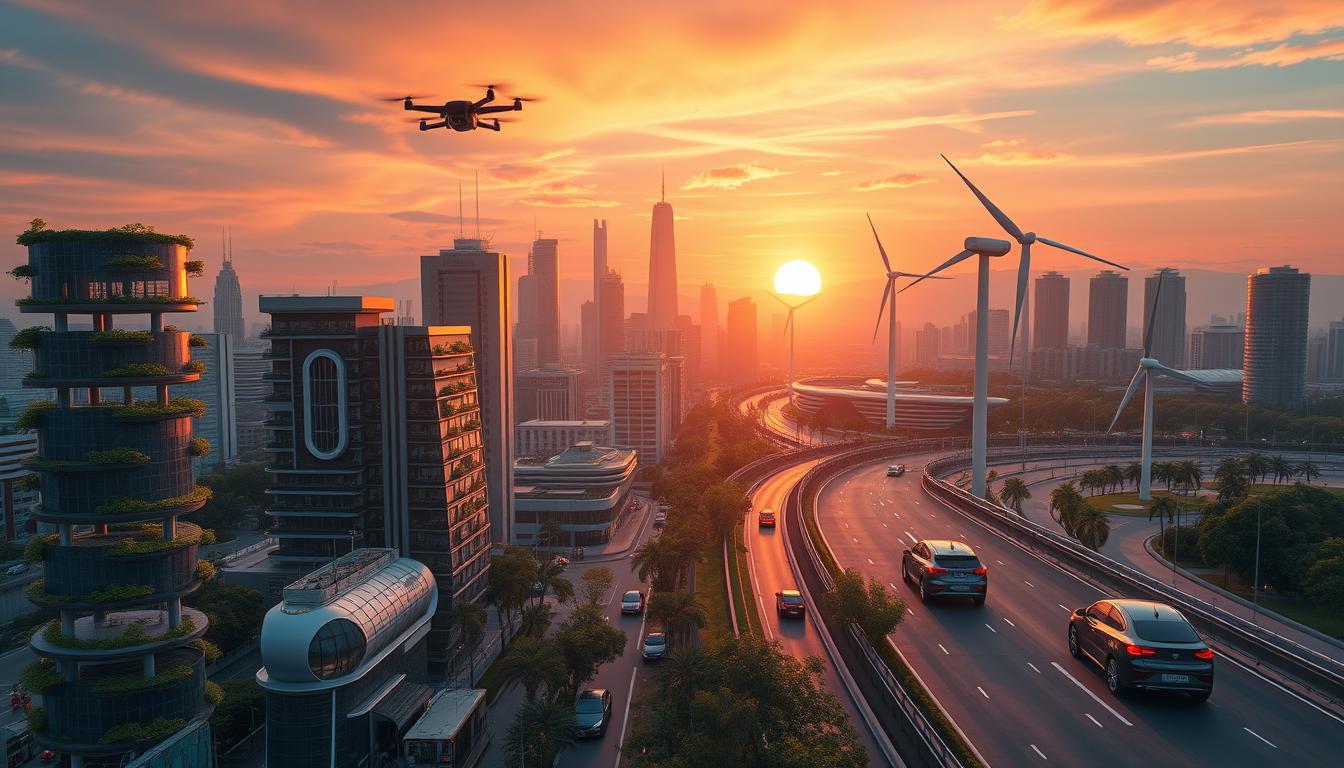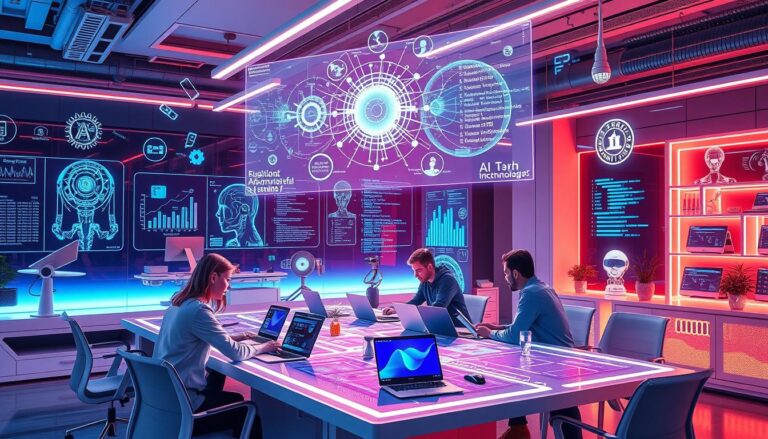Did you know that artificial intelligence uses only 1% of the world’s energy? This small amount might seem minor, but it’s crucial as climate challenges grow. Experts say up to 50% of species could disappear by 2100, and temperatures could rise by 3˚C. Using AI to solve these problems is now more urgent than ever12.
AI can analyze huge amounts of climate data, predict changes, and help make things more sustainable. It’s changing how we protect our planet. For example, AI helps farmers in India grow 30% more per hectare2. It can also find water pollution violations much faster, showing its power in solving big environmental problems1.
As we explore AI’s role in fighting climate change, it’s clear that tech and sustainability go hand in hand. Together, they can make our planet healthier.
Key Takeaways
- AI currently utilizes only 1% of global energy, providing an opportunity for further sustainable applications.
- Predicted temperature increases may reach 3˚C by 2100, emphasizing the need for effective climate solutions.
- Machine learning can enhance agricultural output significantly, as demonstrated by Indian farmers.
- AI can drastically improve environmental compliance enforcement, such as detecting water pollution.
- Innovative technologies in renewable energy are vital for fulfilling sustainability targets amidst rising global challenges.
Understanding AI’s Role in Climate Change Mitigation
In recent years, environmental AI has become key in fighting climate change. It uses advanced tech to help various sectors work better, supporting efforts to reduce climate change. This helps manage resources more efficiently, especially in farming, where AI is making a big difference.
What Is Environmental AI?
Environmental AI uses AI to solve ecological problems. It looks at big data and predicts climate trends. For example, in farming, AI helps use water better and grow more crops, which is good for the environment3.
AI in farming can cut water use by 30% and boost crop yields by 10-15%4. It also helps manage the environment by analyzing data quickly.
Key Technologies Influencing Climate Solutions
Many technologies are helping solve climate problems today. AI makes renewable energy like wind and solar power more efficient. It looks at weather and energy demand in real-time3.
Google’s Project Sunroof has helped install over 3 GW of solar power, cutting CO2 emissions by 2.6 million metric tons a year4. AI also helps use energy better in buildings and design green routes for cars. It even helps capture carbon.
DeepMind’s AI has cut cooling energy use in Google’s data centers by 40%3. This shows how AI and green tech are working together to make our economy greener.
Data-Driven Insights into Climate Patterns
Understanding climate patterns is key for making good decisions in sustainability. Accurate data leads to clear data-driven climate insights. These insights help organizations adapt and respond to environmental changes. Tools for climate data analysis are crucial for making informed strategies to tackle climate challenges.
Importance of Data for Climate Decisions
Reliable climate data is vital for sustainability tech and predicting environmental trends. Organizations using machine learning for environmental impact get better climate forecasts. A report shows that spending on sustainability reporting is 43% more than on innovation, highlighting the need for transparency in climate strategies5.
Also, 56% of organizations haven’t used AI to reach sustainability goals. This shows a gap in using technology to improve decision-making5.
Tools for Climate Data Analysis
Advanced tools like AI-based climate modeling software and satellite imagery are key in environmental research. IBM’s Environmental Intelligence Suite has helped predict and prevent grain contamination, saving millions for European agriculture5. AI has also improved wind and solar forecasts by 15% and 30% for a Brazilian renewable power producer, showing the power of data in energy forecasts5.
Organizations must invest in tools for climate data analysis for thorough climate evaluations and sustainable outcomes. IBM’s Envizi ESG Suite tracks over 15,000 data types, aiding in corporate sustainability reporting and saving thousands of man-hours5. The integration of AI in climate data analysis, as highlighted in an August 2021 report, emphasizes the global need for responsible AI to support climate action6.
This approach helps combine operational and environmental data for better predictions and mitigation of disruptions. It aligns with executives’ recognition of generative AI’s role in advancing sustainability initiatives at scale5.
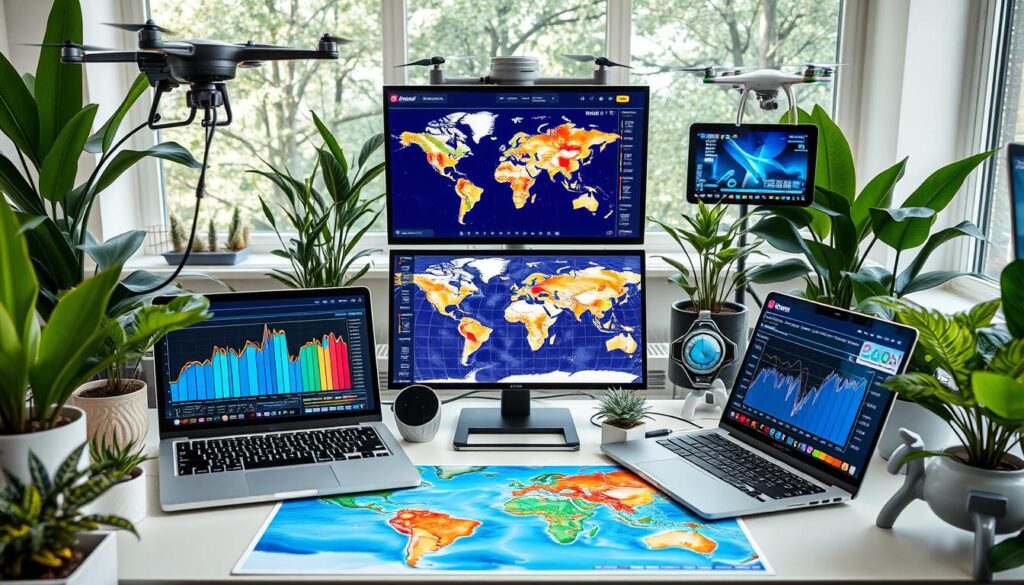
| Tool | Functionality | Impact on Climate Decision Making |
|---|---|---|
| Environmental Intelligence Suite | Predicts grain contamination | Saves millions in agricultural costs |
| AI Climate Modeling Software | Forecasts weather patterns | Improves accuracy of climate predictions |
| Envizi ESG Suite | Tracks sustainability data | Efficient reporting and greenhouse gas reduction |
| Satellite Imaging | Monitors environmental changes | Enhances understanding of climate impacts |
| Machine Learning Algorithms | Analyzes climate data | Informs strategy and improves outcomes |
As these technologies become more widespread, organizations will better understand complex data. They will develop effective strategies to tackle climate change challenges56.
Enhancing Renewable Energy Efficiency with AI
AI is making a big difference in renewable energy. It helps make energy use better and cuts down on waste. This leads to more use of green energy sources.
Smart Grid Technology
Smart grid tech uses AI to manage electricity better. It watches over energy use and adjusts it to fit demand. This means less need for dirty energy sources7.
Google showed how AI can cut down energy use by 40% in data centers8. This tech is key for a cleaner energy future and reaching carbon neutrality.
Predictive Maintenance for Energy Systems
Predictive maintenance AI is crucial for keeping energy systems running smoothly. It spots problems before they happen, saving time and money7. It also helps make better batteries for storing energy.
This makes green energy more reliable. It helps industries work better and cut down on pollution7. AI is a big step towards a greener world.
AI Applications in Sustainable Agriculture
Sustainable agriculture is key to feeding the world’s growing population, expected to hit 9.7 billion by 2050. AI helps make food production more efficient. It uses new tech to improve farming, making it more sustainable.
Precision Farming Techniques
Precision farming uses AI to check soil health and weather. It makes farming better and keeps the environment safe. Edge AI lets farmers use low-energy systems that work on their own, solving many farming problems9.
For example, John Deere’s See & Spray cuts herbicide use by up to 90% in cotton fields. This shows AI’s power in reducing harm to the environment10. It also saves money and boosts farm output.
Crop Monitoring and Yield Prediction
Crop monitoring has changed thanks to AI, like drones and machine learning. These tools help manage crops better and use resources wisely. Studies show edge AI helps reduce food waste and improve safety11. The University of Liège found AI helps farming be more sustainable, making predictions better and helping farmers make smart choices9.
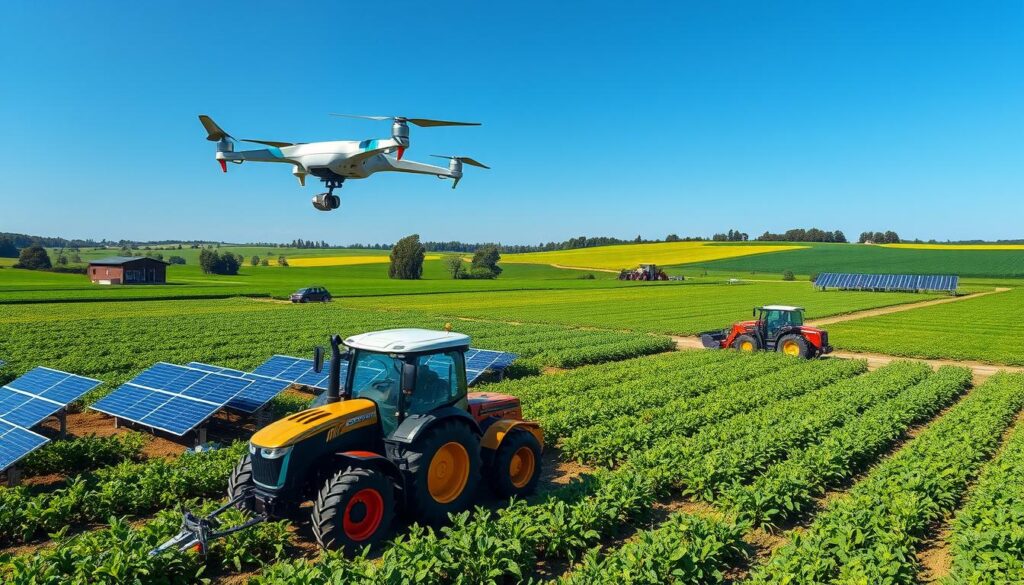
Addressing Climate Risks Through AI Modeling
AI modeling is changing how we deal with climate change. It uses smart algorithms and lots of data to predict climate scenarios. This helps leaders make plans to fight climate threats.
It gives insights to areas at risk, helping them get ready for disasters. This way, communities can better face natural disasters.
Climate Impact Simulations
Environmental AI helps simulate climate impacts. It looks at current and future risks. This lets us understand the effects of disasters like floods and wildfires.
AI tools help cities see their risk levels. They use past weather, current climate models, and future trends. This gives policymakers detailed information1213.
Risk Assessment for Natural Disasters
AI and data analysis are key for disaster risk assessment. AI helps spot patterns in climate hazards. For example, Northeastern University uses machine learning for better risk assessments13.
AI also helps predict and prepare for disasters. It analyzes data in real-time. This makes weather and environmental forecasts more accurate, helping communities get ready14.

Leveraging AI for Waste Management Solutions
Communities are working hard to be more sustainable. AI is playing a big role in managing waste better. It helps cities recycle more and send less waste to landfills.
Intelligent Waste Sorting Systems
AI-powered systems make recycling much better. They can sort waste up to 90% accurately, reducing contamination. This helps cities meet their sustainability goals and keeps the environment clean.
Predictive Analytics for Recycling
AI changes how cities recycle by using data. It helps cities plan better and save money. AI can also cut down CO2 emissions from landfills by up to 20%.
These systems make sure waste management is both efficient and green. They help cities use resources wisely.
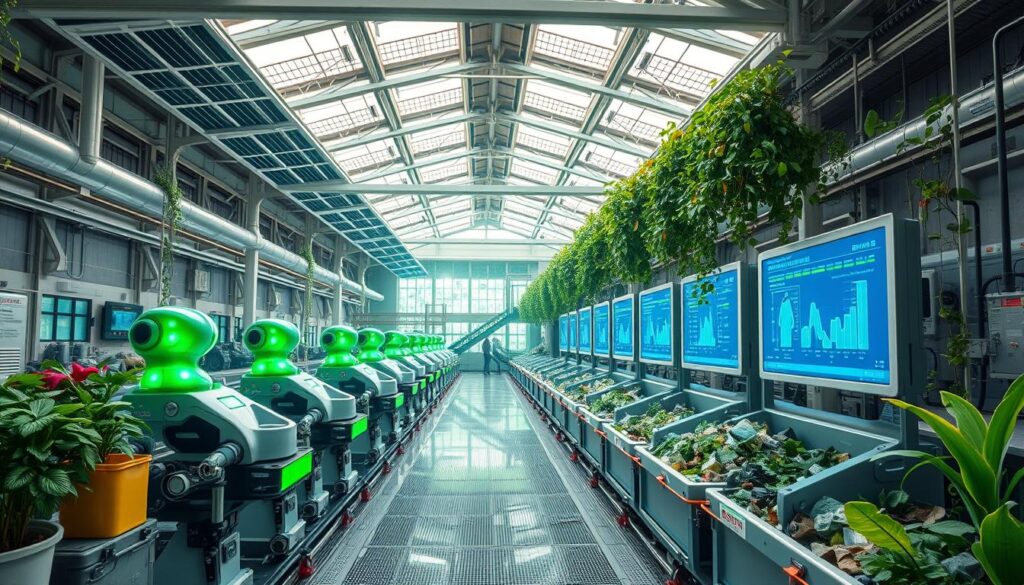
Optimizing Energy Consumption with AI
In today’s world, AI and energy optimization are key. Smart buildings use AI to manage energy well. They analyze patterns to improve energy use in heating, cooling, and lighting.
This makes buildings more efficient and helps the environment.
Smart Buildings and IoT Integration
Smart buildings with IoT devices change how we manage energy. They can cut energy use by up to 29%, says the U.S. Department of Energy15. Smart tech lets us monitor and control energy use in real-time.
For example, medium office buildings could use 8% to 19% less energy by 2050 with AI16. As more buildings use these technologies, they’ll leave a smaller environmental footprint.
Energy Usage Analytics
AI analytics help building managers make better choices. They can cut energy use by up to 40% and carbon emissions by 90% by 205016. Companies like Trane Technologies aim to cut emissions by 1 gigaton by 203015.
Big tech companies like Microsoft and Google are also working on this. They’re using more renewable energy but still see emissions rise. This data helps them adjust and support sustainability efforts.

Transportation Innovations Powered by AI
Transportation is changing fast thanks to AI. This includes self-driving cars and smarter routes. These changes make travel safer and cut down on pollution, helping our planet.
Autonomous Vehicles and Emissions Reduction
Self-driving cars could be the answer to cutting down emissions. They use smart algorithms to drive better and avoid traffic jams. This means they use less fuel and drive more eco-friendly.
The global market for car AI was worth $2.99 billion in 2022. It’s expected to grow by 25.5% from 2023 to 203017. This growth is linked to how well self-driving cars can solve traffic problems.
Route Optimization for Lower Carbon Footprint
AI helps make routes more efficient, which is good for the environment. It looks at real-time data to find the best paths. This cuts down on fuel use and saves money.
It also makes delivery systems better by reducing waste and improving service. It helps companies meet their green goals and serve customers better.
As AI in transport keeps getting better, working together can lead to big wins. It’s a chance to make a difference for our planet and people. With ongoing tech advancements, we can tackle climate change together17.
Community Engagement and Awareness Through AI
Community engagement is key in fighting climate change. Artificial intelligence helps with outreach and education, raising awareness about climate issues. It lets organizations send messages to different groups, getting communities to push for change.
Educating the Public on Climate Issues
Interactive platforms with AI boost public climate awareness. For example, the UNEP’s World Environment Situation Room uses AI to analyze environmental data. It helps understand how CO2 and glacier changes affect global warming18. AI-powered tools make complex climate topics easier for people to grasp.
AI-Driven Climate Action Campaigns
AI helps make climate campaigns more effective. Groups like Ocean Cleanup use AI to track and clean up ocean plastic19. This shows how tech can support green efforts. It gets more people involved in environmental actions, making communities work together for climate goals.
| Organization | AI Application | Impact |
|---|---|---|
| United Nations | AI in environmental monitoring | Improves public transparency and data dissemination18 |
| Ocean Cleanup | AI systems for waste tracking | Increases efficiency in marine cleanup operations19 |
| GE Renewable Energy | AI in wind turbines | Enhances wind energy output19 |
| IBM | Weather forecasting AI | Improves climate modeling accuracy19 |
AI offers new chances for community involvement in climate efforts. With the right design, AI can spark meaningful talks and actions on climate change. It ensures the public is actively involved in creating a sustainable future.
Policy Development and Climate Strategy
Artificial Intelligence (AI) is now key for helping policymakers tackle climate change. It uses data analysis and modeling to create strong climate rules. AI helps governments make plans that support green practices.
It also helps understand big climate issues, especially in areas hit hard by climate change.
Informing Policymakers with AI
AI is crucial in making climate strategy AI better. It can look at huge amounts of data. For example, AI’s water use is expected to be six times that of Denmark, showing the need for smart policies20.
Countries are urged to use AI ethically to lessen its environmental harm. Laws like those from the EU and the US aim to reduce AI’s environmental impact20.
Case Studies of Successful AI Policies
Looking at successful case studies AI climate shows how AI helps in climate policy. In Ireland, AI could use a lot of energy, so they need to find ways to use it efficiently20.
The UN is working on AI rules to help the planet. Countries like Indonesia and Brazil are setting up AI systems that fit their needs21.
The Future of AI and Climate Sustainability
The future AI sustainability landscape is getting more exciting. New technologies are coming to help with climate action. Machine learning and data analytics will help us understand climate better and predict its effects more accurately.
AI in environmental fields is expected to add $5.2 trillion USD to the global economy by 2030. This shows how important these technologies are for climate action22.
Upcoming Technologies to Watch
New AI solutions will change many sectors, like energy and farming. They could cut greenhouse gas emissions by 4% in 2030. That’s a big reduction of 2.4 Gt CO2e22.
Looking ahead, working together is key. Research groups, governments, and private companies need to team up. This partnership is crucial for advancing tech and promoting sustainability.
Collaborations for a Sustainable Future
The scope for collaborations for sustainability is huge. Almost 90% of big U.S. companies are using generative AI in their work23. To make the most of AI, we need to link it with sustainability goals.
By using AI, industries can aim for big decarbonization goals. They can also build a strong, sustainable economy with the right solutions.
FAQ
What is Environmental AI?
How does AI influence renewable energy efficiency?
What technologies are key to climate solutions?
Why is data analysis important in climate strategies?
What are precision farming techniques?
How does AI assist in waste management?
In what ways does AI help evaluate climate risks?
How can AI optimize energy consumption?
What is the role of AI in transportation innovations?
How can AI facilitate community engagement regarding climate issues?
What impact does AI have on policy development for climate strategy?
What does the future hold for AI in climate sustainability?
Source Links
- AI and environmental challenges – https://environment.upenn.edu/events-insights/news/ai-and-environmental-challenges
- Artificial Intelligence—A Game Changer for Climate Change and the Environment – https://news.climate.columbia.edu/2018/06/05/artificial-intelligence-climate-environment/
- How can artificial intelligence help tackle climate change? – https://greenly.earth/en-us/blog/ecology-news/how-can-artificial-intelligence-help-tackle-climate-change
- AI and Climate Change: Leveraging Technology for Environmental Sustainability in 2024 – https://www.linkedin.com/pulse/ai-climate-change-leveraging-technology-environmental-dave-balroop-amqrc
- AI and the future of sustainability: A climate week conversation with IBM experts – IBM Blog – https://www.ibm.com/blog/climate-week-qa-ai-sustainability/
- PDF – https://www.gpai.ai/projects/climate-change-and-ai.pdf
- Leveraging AI to Tackle Climate Change: Innovations for Sustainability | Traction Technology – https://www.tractiontechnology.com/blog/ai-and-climate-change-pioneering-technologies-for-a-sustainable-future
- Moving Towards a More Sustainable Future Using AI | Capitol Technology University – https://www.captechu.edu/blog/moving-towards-more-sustainable-future-using-ai
- The Dawn of Edge AI in Sustainable Agriculture – SynBioBeta – https://www.synbiobeta.com/read/the-dawn-of-edge-ai-in-sustainable-agriculture
- Leveraging AI to Foster Climate-Resilient & Sustainable Agriculture – https://www.cutter.com/article/leveraging-ai-foster-climate-resilient-sustainable-agriculture
- Advanced artificial intelligence: A revolution for sustainable agriculture – https://www.sciencedaily.com/releases/2024/06/240618115419.htm
- The AI gambit: leveraging artificial intelligence to combat climate change—opportunities, challenges, and recommendations – https://pmc.ncbi.nlm.nih.gov/articles/PMC8522259/
- AI for Climate and Sustainability | Institute for Experiential AI – https://ai.northeastern.edu/news/ai-for-climate-and-sustainability
- AI for Climate Change: Revolutionizing Solutions for a Sustainable Future – Transcend – https://transcendinfra.com/ai-for-climate-change/
- Will AI Help or Hurt Sustainability? Yes | Andrew Winston – https://sloanreview.mit.edu/article/will-ai-help-or-hurt-sustainability-yes/
- Potential of artificial intelligence in reducing energy and carbon emissions of commercial buildings at scale – Nature Communications – https://www.nature.com/articles/s41467-024-50088-4
- AI in Transportation: Benefits, Use Cases, and Examples – https://appinventiv.com/blog/ai-in-transportation/
- How artificial intelligence is helping tackle environmental challenges – https://www.unep.org/news-and-stories/story/how-artificial-intelligence-helping-tackle-environmental-challenges
- 8 Ways Artificial Intelligence Can Contribute to Environmental Conservation – https://2030.builders/8-ways-ai-can-contribute-to-environmental-conservation/
- AI has an environmental problem. Here’s what the world can do about that. – https://www.unep.org/news-and-stories/story/ai-has-environmental-problem-heres-what-world-can-do-about
- Aligning AI and Climate Governance – https://unu.edu/ehs/series/aligning-ai-and-climate-governance
- How AI Is Changing the Face of Sustainability – https://www.csrwire.com/press_releases/806551-how-ai-changing-face-sustainability
- AI and Sustainability: The Power of Integration – https://www.bain.com/insights/ai-and-sustainability-power-of-integration-ceo-sustainability-guide-2024/
